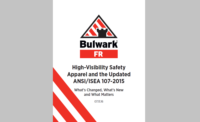History
ANSI/ISEA 107-2015 is latest revision of a voluntary industry consensus standard that was first published in 1999 and revised in 2004 and 2010. Prior to its initial publication there was no regulation or guideline for the design, performance or materials for high visibility PPE in the United States.
This new edition consolidates the requirements of ANSI/ISEA 107-2010 and ANSI/ISEA 207, American National Standard for Public Safety Vests in an effort to establish a single, comprehensive document that considers all occupational tasks.
Scope
This standard specifies performance requirements for high-visibility safety apparel and accessory PPE. For the purpose of this standard, the term “high-visibility safety apparel (HVSA)” shall be used to mean apparel and accessory PPE intended to provide conspicuity to the user in hazardous situations under any light conditions by day and under illumination by vehicle headlights in the dark or other low light conditions.
Performance requirements are included for color, retroreflection, and minimum areas of retroreflective and combined-performance materials, as well as the recommended configuration of the materials. Performance requirements are also provided for the color, physical properties, and minimum areas of background materials used in the construction of HVSA and accessories. Test methods are provided in the standard to ensure that a minimum level of visibility is maintained when garments are subjected to ongoing care procedures. These specifications may prescribe a wide variety of occupational HVSA, but shall not be applied to firefighter turnout gear.
Why this standard is important
Since 1999, the standard has been recognized by federal, state and local authorities as well as private industry. Current US Department of Transportation, Federal Highway Administration (FHWA) regulations have required workers on or near Federal-aid highways to wear Class 2 or Class 3 garments, and the 2009 revision to the Manual on Uniform Traffic Control Devices (MUTCD) extends this provision to workers on all roadways in the United States.
The need to be seen is recognized as a critical issue for worker safety. Low visibility is a serious hazard for all workers who must perform tasks near moving vehicles or equipment. Workers must be visible to vehicle operators in all lighting conditions and against complex environmental backgrounds. The sooner a vehicle operator sees a pedestrian worker, the longer the operator has to avoid an incident. High visibility safety apparel and accessories dramatically enhance worker visibility.
Key Definitions
High-visibility safety apparel (HVSA): Personal protective safety clothing intended to provide conspicuity during both daytime, nighttime and other low-light condition usage.
Type O (“off-road”) – Occupational HVSA for Non-Roadway Use
Type O HVSA provides daytime and nighttime visual conspicuity enhancement for workers in occupational environments which pose struck-by hazards from moving vehicles, equipment and machinery, but which will not include exposure to traffic on public access highway rights-of-way or roadway temporary traffic control (TTC) zones.
Type R (“roadway”) – Occupational HVSA for Roadway Use
Type R HVSA provides daytime and nighttime visual conspicuity enhancement for workers in occupational environments which include exposure to traffic (vehicles using the highway for purposes of travel) from public access highway rights-of-way, or roadway temporary traffic control (TTC) zones or from work vehicles and construction equipment within a roadway temporary traffic control (TTC) zone.
Type P (“public safety”) – Occupational HVSA for Emergency and Incident Responders and Law Enforcement Personnel
Type P HVSA provide daytime and nighttime visual conspicuity enhancement for emergency and incident responders and law enforcement personnel in occupational environments which include exposure to traffic (vehicles using the highway for purposes of travel) from public access highway rights-of-way, or roadway temporary traffic control (TTC) zones, or from work vehicles and construction equipment within a roadway temporary traffic control (TTC) zone or from equipment and vehicles within the activity area. Type P HVSA provides additional options for emergency responders, incident responders and law enforcement who have competing hazards or require access to special equipment.
Performance Class 1 (Type O)
Performance Class 1 provides the minimum amount of high-visibility materials required to differentiate the wearer visually from non-complex work environments, in scenarios in which the struck-by hazards will not be approaching at roadway speeds, and therefore operative detection and identification distances in the work environment can be shorter than in other situations without compromising safety
Performance Class 2 (Type R or P)
Performance Class 2 provides for the use of additional amounts of high-visibility materials, which may allow design opportunities to define the human form more effectively. Performance Class 2 HVSA have the potential to provide longer detection and identification distances, and increased conspicuity performance compared to Performance Class 1 HVSA.
Performance Class 3 (Type R or P)
Performance Class 3 can offer greater visibility to the wearer in both complex backgrounds and through a full range of body movements by mandatory placement of background, retroreflective and combined-performance materials on sleeves and pant legs (if present). Regardless of the area of materials used, a sleeveless garment or vest alone shall not be considered Performance Class 3.
What employers should do
Type O HVSA Scenarios – Occupational HVSA for Non-Roadway Use
Examples of pedestrian workers who could operate in this class may include:
- those workers directing vehicle operators to parking/service locations;
- workers retrieving shopping carts from parking areas;
- those exposed to the hazards of warehouse equipment traffic;
- oil and gas extraction workers;
- refinery workers; and
- mine workers.
Example Type O worker scenarios, for occupational activities which may:
- permit full and undivided attention to approaching traffic;
- provide ample separation of the pedestrian worker from conflicting vehicle traffic; and
- permit optimum conspicuity in backgrounds that are not complex;
Type R HVSA Scenarios – Occupational HVSA for Use in Proximity to Roadways
Examples of workers who could operate in this class may include:
- roadway construction workers;
- utility workers;
- survey crews;
- railway workers;
- forestry workers;
- school crossing guards;
- parking and/or toll gate personnel;
- airport baggage handlers/ground crew;
- emergency response personnel;
- law enforcement personnel;
- accident site investigators;
- roadway maintenance workers;
- flagging crews;
- towing operators; and
- road assistance/courtesy patrols.
Type P HVSA Scenarios – Occupational HVSA for Emergency and Incident Responders and Law Enforcement Personnel
Examples of pedestrian workers who could operate in this class may include:
- law enforcement personnel;
- emergency response personnel;
- road closure personnel;
- firefighting personnel; and
- accident site investigators.



